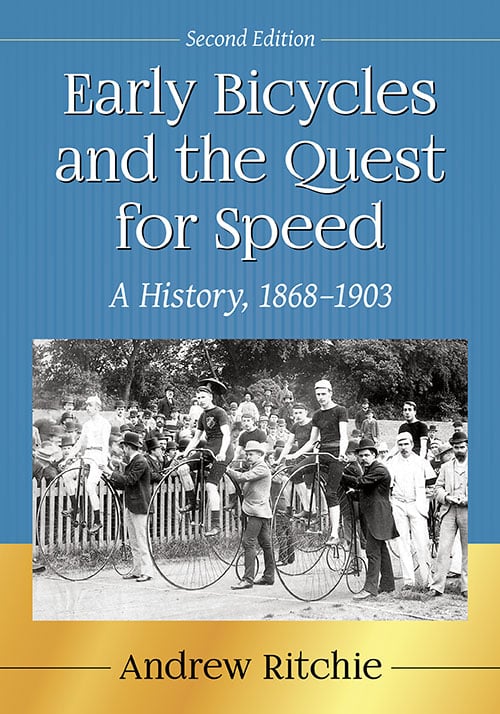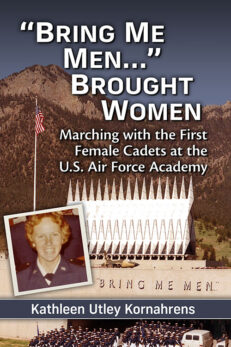Early Bicycles and the Quest for Speed
A History, 1868–1903, 2d ed.
$39.95
In stock
About the Book
From the earliest “velocipedes” through the advent of the pneumatic tire to the rise of modern road and track competition, this history of the sport of bicycle racing traces its role in the development of bicycle technology between 1868 and 1903.
Providing detailed technical information along with biographies of racers and other important personalities, the book explores this thirty-year period of early bicycle history as the social and technical precursor to later developments in the motorcycle and automobile industries.
About the Author(s)
Bibliographic Details
Andrew Ritchie
Format: softcover (7 x 10)
Pages: 387
Bibliographic Info: 200 photos, notes, bibliography index
Copyright Date: 2018
pISBN: 978-1-4766-7107-9
eISBN: 978-1-4766-3046-5
Imprint: McFarland
Table of Contents
Acknowledgments v
Preface 1
Introduction: Sport, Speed, Technology and Modernity 5
Chapter One. The Origins of Bicycle Racing
1. The Earliest Bicycle Racing 15
2. The Beginning of Commercial Bicycle Production, 1865–69 19
3. Velocipede Developments in France and the United States, 1867–69: Their Influence on the British Sport 20
4. Charles Spencer’s London Gymnasium 27
5. Bicycle Competition as Athletic Novelty and Public Spectacle 30
6. Links Between Manufacture and Sport 34
7. Varieties of Competitive Activity 38
8. An Elite Emerges: Match Racing and Championships 45
Chapter Two. Expansion of Bicycling in Britain
1. A Cutting-Edge, Modern, Technological Sport 50
2. Technological Innovation at the Birth of Cycle Sport 54
3. Amateurism and Professionalism in the 1870s 59
4. Cycling at Oxford and Cambridge Universities 62
5. “Muscular Christianity”: The Cycling Career of Ion Keith-Falconer 65
6. “Gentlemen, Not Players’: The Establishment of the Bicycle Union, 1877–78 69
7. John Keen (1849–1902) 77
8. A New Athletic Liberalism 78
9. The Bicycle Touring Club, 1878 80
10. Public Recognition of Bicycling 83
Chapter Three. The Beginnings of Bicycle Racing in the United States
1. American Cycling in the Late 1870s 88
2. The Foundations of American Cycling 91
3. Harry Etherington: Bicycling Entrepreneur and Promoter of Endurance Spectacles 101
4. Etherington’s 1879 “Anglo-French” Tour of America and Its Repercussions 105
5. The Founding of the League of American Wheelmen 113
Chapter Four. Expansion of the High-Wheel Sport
1. The New Sport Expands and Matures 121
2. Bicycle Racing Infrastructure: Road Conditions and Track Construction 125
3. Competition in Britain: Amateurism and Professionalism in the Late 1870s and 1880s 133
4. Two Professionals: George Waller (c.1855–1900) and H.O. Duncan
(1862–1945) 138
5. Competition in France: The Tendency towards an “Open” Sport 141
6. British “Meets,” the Springfield Tournaments and the Growth of International Competition 143
7. New Departures: Tricycle Racing and Recreational Tricycling 155
Chapter Five. Sport, Speed and Safety, 1885–93
1. Design and Technological Ferment within the Bicycle Industry and the Sport 163
2. Alternative Designs: the “Facile” and the “Kangaroo.” 165
3. The Rear-Driven “Rover Safety” and the First “Safety” Races 169
4. The Rise of Road Racing 176
5. Competition and the Invention of the Revolutionary Pneumatic Tire 181
6. The Cycling Revolution, 1888–93 188
Chapter Six. The Foundations of Modern Road Racing
1. Road Competition in Britain and France 193
2. The Foundations of Modern Professional Road Racing in France: Sport as Business and Athletic Celebration 195
3. Opposition to Organized Road Racing in Britain 205
4. George Lacy Hillier: Amateurism Versus the “New Professionalism” 209
5. Road Racing in the United States 216
6. Racing Bicycles on Public Roads: Danger or Celebration? 222
Chapter Seven. International Competition
1. Bicycle Racing as a Global Sport 228
2. National Championships, International Competition and Early “World Championships” 229
3. The International Cyclists’ Association, 1892 238
4. World Champion: The International Career of Arthur Zimmerman 245
5. Amateurism, Professionalism and Licensing Schemes 254
6. The 1896 Olympic Games 257
7. Rival Philosophies of Cycling Competition and Sporting Excellence in the 1890s 260
Chapter Eight. Bicycle Racing and Modernity
1. The Transformation of Bicycle Racing in the 1890s 263
2. Long-Distance Races on the Road 267
3. Stage-Riding and Stage-Races on the Road and the Origins of the Tour de France 269
4. “Stayer” (Paced) Races 272
5. Six-Day Races 277
6. Professionalization and Commercialization 280
7. “Gigantism” and the Pursuit of Records 284
8. Sensationalism and “Gigantomania” 286
9. The Emergence of a Modern, Professional Sports Structure 287
Chapter Nine. Non-Competitive Cycling in the 1890s 291
Epilogue
1. A Period of Intensive Technological Change and Sport Development 309
2. Reviewing the Dynamics of Social and Technological Change 314
A. Agents of change within the sport and industry 314
B. The spectacular growth of the bicycle industry and the class penetration of cycling 315
C. Global expansion 316
D. Speed and modernity 318
3. Sport as Moral/Physical Crusade and Sport as Business 321
Chapter Notes 323
Bibliography 364
Index 373
Book Reviews & Awards
“Highly detailed account of the early history of bicycle racing…richly illustrated…[the illustrations] provide a fascinating view of the late 190th century”—Choice





